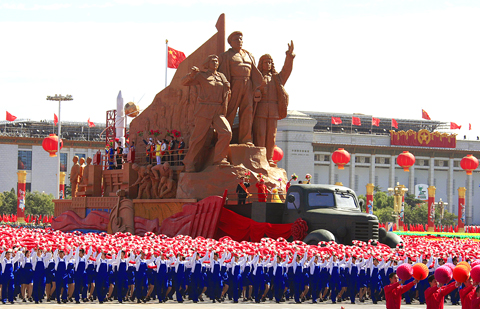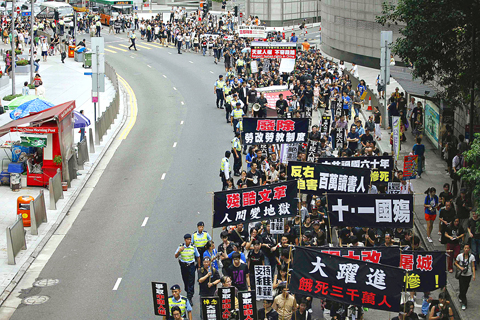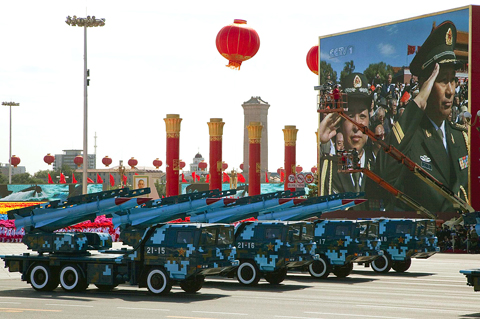China celebrated its wealth and rising might with a show of goose-stepping troops, gaudy floats and nuclear-capable missiles in Beijing yesterday, 60 years after Mao Zedong (毛澤東) proclaimed its embrace of communism.
Tiananmen Square became a high-tech stage to celebrate the birth of the People’s Republic of China (PRC) on Oct. 1, 1949, with the Chinese Communist Party (CCP) leadership and guests watching a meticulously disciplined show of national confidence.
Celebrations began in the morning with troops firing cannons and raising the red national flag while President Hu Jintao (胡錦濤), wearing a slate grey “Mao” suit, looked on from the Gate of Heavenly Peace.

PHOTO: REUTERS
Hu descended to Beijing’s main thoroughfare and inspected rows of troops, riding past them in a black limousine and bellowing repeatedly, “Hello comrades, hard-working comrades!”
“From here it was that Chairman Mao solemnly announced the founding of the People’s Republic of China, and from then the Chinese people stood up,” Hu told the guests and troops. “Today a socialist China embracing modernization, embracing the world and embracing the future stands lofty and firm.”
The two-hour parade of 8,000 soldiers, tanks and missiles, 60 elaborate floats and 100,000 well-drilled civilians was a proud moment for many Chinese, watching the spectacle across the country on TV. Tiananmen Square was lit up last night with a huge fireworks display.

PHOTO: REUTERS
The government also wanted the day of extraordinary spectacle and security to make the case that its formula of strict one-party control and rapid growth remains the right one for hauling the world’s third-biggest economy into prosperity.
The soldiers goose-stepping past at exactly 116 steps a minute carried the theme that the CCP knows how to run a show — and the country.
“The parade is reminiscent of the old Soviet-era May Day parades that bristled with the latest missiles and served as a warning to the US,” said Wendell Minnick, Asia bureau chief of Defense News.

PHOTO: EPA
“For many in the US who watch the Chinese military, this is a real intelligence bonanza. Many of the weapons, particularly missiles, have not been seen by the public before. US intelligence analysts will go nuts over the photos,” he said.
“Of particular concern for the US and Japan was the display of the new road-mobile Dong Feng-31 intercontinental ballistic missile [ICBM],” Minnick said.
“China is clearly signaling to the US it has a nuclear strike capability that can hit Washington. Prior silo-based ICBMs such as the aging DF-5 were unreliable and easy for the US to target. But the new road-mobile ICBMs China is producing will be very difficult to locate during a war,” he said.
Short-range Dong Feng 11 and 15 were also displayed, he said, noting that these kinds of missiles were used during the Taiwan missile crisis of 1996.
“The parade is a clear signal to Taiwan. The variety and quality of new arms on display has to be intimidating to Taiwan military officials. China is basically saying to Taiwan independence advocates, ‘forget it, you’re going to lose.’”
But even as the displays celebrated the PRC, security cordons prevented residents from seeing the parade, with central Beijing emptied of all passers-by.
“It’s not really for us ordinary people, is it?” said Wang Chenggong, a migrant worker from Henan Province trying to watch a TV near a crowded streetside stall.
Residents on the parade route were banned from peeking out their windows.
“Go home! Leave now! Go watch TV at home!” a policeman yelled through a bullhorn at a crowd gathering kilometers from the square.
After the military parade, floats lauding China’s history, achievements and regions passed by.
They included a farm produce float with two model cows, one showing China’s space program with a lunar orbiter and an Olympic Games display with a model of the Bird’s Nest stadium.

SECURITY: As China is ‘reshaping’ Hong Kong’s population, Taiwan must raise the eligibility threshold for applications from Hong Kongers, Chiu Chui-cheng said When Hong Kong and Macau citizens apply for residency in Taiwan, it would be under a new category that includes a “national security observation period,” Mainland Affairs Council (MAC) Minister Chiu Chui-cheng (邱垂正) said yesterday. President William Lai (賴清德) on March 13 announced 17 strategies to counter China’s aggression toward Taiwan, including incorporating national security considerations into the review process for residency applications from Hong Kong and Macau citizens. The situation in Hong Kong is constantly changing, Chiu said to media yesterday on the sidelines of the Taipei Technology Run hosted by the Taipei Neihu Technology Park Development Association. With

CARROT AND STICK: While unrelenting in its military threats, China attracted nearly 40,000 Taiwanese to over 400 business events last year Nearly 40,000 Taiwanese last year joined industry events in China, such as conferences and trade fairs, supported by the Chinese government, a study showed yesterday, as Beijing ramps up a charm offensive toward Taipei alongside military pressure. China has long taken a carrot-and-stick approach to Taiwan, threatening it with the prospect of military action while reaching out to those it believes are amenable to Beijing’s point of view. Taiwanese security officials are wary of what they see as Beijing’s influence campaigns to sway public opinion after Taipei and Beijing gradually resumed travel links halted by the COVID-19 pandemic, but the scale of

A US Marine Corps regiment equipped with Naval Strike Missiles (NSM) is set to participate in the upcoming Balikatan 25 exercise in the Luzon Strait, marking the system’s first-ever deployment in the Philippines. US and Philippine officials have separately confirmed that the Navy Marine Expeditionary Ship Interdiction System (NMESIS) — the mobile launch platform for the Naval Strike Missile — would take part in the joint exercise. The missiles are being deployed to “a strategic first island chain chokepoint” in the waters between Taiwan proper and the Philippines, US-based Naval News reported. “The Luzon Strait and Bashi Channel represent a critical access

Pope Francis is be laid to rest on Saturday after lying in state for three days in St Peter’s Basilica, where the faithful are expected to flock to pay their respects to history’s first Latin American pontiff. The cardinals met yesterday in the Vatican’s synod hall to chart the next steps before a conclave begins to choose Francis’ successor, as condolences poured in from around the world. According to current norms, the conclave must begin between May 5 and 10. The cardinals set the funeral for Saturday at 10am in St Peter’s Square, to be celebrated by the dean of the College